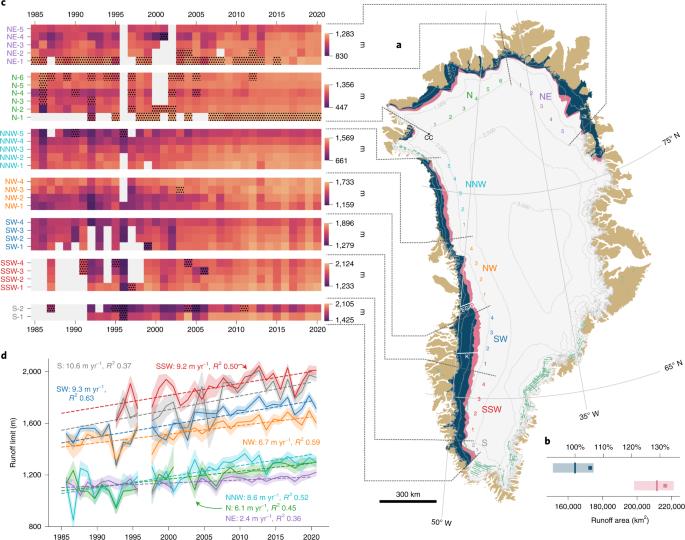Increasing surface runoff from Greenland’s firn areas
IF 29.6
1区 地球科学
Q1 ENVIRONMENTAL SCIENCES
引用次数: 9
Abstract
At high elevations of ice sheets, melting snow generally percolates and refreezes, so does not contribute to the shrinking of the ice sheet. Here, we systematically map the runoff area of the Greenland ice sheet using surface rivers visible on satellite imagery. Between 1985 and 2020, the maximum runoff elevation rose by 58–329 metres, expanding the runoff area by 29% (–8%/+6%). Excess melt beyond the refreezing capacity of pores in snowfall has created near-impermeable ice slabs that sustain surface runoff even in cooler summers. We show that two surface mass balance models over-estimate the runoff area by 16–30%. Once restricted to our observed areas, they indicate that 5–10% of recent runoff probably comes from the expanded runoff area. Runoff from higher elevations is sensitive to projected warming as further increases in the runoff limit will increase the runoff area disproportionately. Ice that melts at high elevation often refreezes and, therefore, does not contribute to the shrinking of ice sheets. Here, the authors show that the elevation at which melting ice starts to contribute to runoff has increased over recent years in Greenland, expanding the runoff area by 29%.

格陵兰杉林地区地表径流增加
在冰原的高海拔地区,融雪一般会渗入地下重新结冰,因此不会造成冰原的缩小。在这里,我们利用卫星图像上可见的地表河流,系统地绘制了格陵兰冰盖的径流面积图。从 1985 年到 2020 年,最大径流海拔上升了 58-329 米,径流面积扩大了 29%(-8%/+6%)。超出降雪孔隙再冻结能力的过量融雪形成了近乎不透水的冰板,即使在较凉爽的夏季也能维持地表径流。我们的研究表明,两个地表质量平衡模型高估了 16-30% 的径流面积。一旦局限于我们观测到的区域,它们表明近期径流的 5-10%可能来自扩大的径流区。来自高海拔地区的径流对预计的气候变暖非常敏感,因为径流极限的进一步提高将不成比例地增加径流面积。在高海拔地区融化的冰通常会重新冻结,因此不会造成冰原的缩小。作者在本文中指出,近年来格陵兰岛融冰开始产生径流的海拔高度有所上升,径流面积扩大了 29%。
本文章由计算机程序翻译,如有差异,请以英文原文为准。
求助全文
约1分钟内获得全文
求助全文
来源期刊

Nature Climate Change
ENVIRONMENTAL SCIENCES-METEOROLOGY & ATMOSPHERIC SCIENCES
CiteScore
40.30
自引率
1.60%
发文量
267
审稿时长
4-8 weeks
期刊介绍:
Nature Climate Change is dedicated to addressing the scientific challenge of understanding Earth's changing climate and its societal implications. As a monthly journal, it publishes significant and cutting-edge research on the nature, causes, and impacts of global climate change, as well as its implications for the economy, policy, and the world at large.
The journal publishes original research spanning the natural and social sciences, synthesizing interdisciplinary research to provide a comprehensive understanding of climate change. It upholds the high standards set by all Nature-branded journals, ensuring top-tier original research through a fair and rigorous review process, broad readership access, high standards of copy editing and production, rapid publication, and independence from academic societies and other vested interests.
Nature Climate Change serves as a platform for discussion among experts, publishing opinion, analysis, and review articles. It also features Research Highlights to highlight important developments in the field and original reporting from renowned science journalists in the form of feature articles.
Topics covered in the journal include adaptation, atmospheric science, ecology, economics, energy, impacts and vulnerability, mitigation, oceanography, policy, sociology, and sustainability, among others.
 求助内容:
求助内容: 应助结果提醒方式:
应助结果提醒方式:


